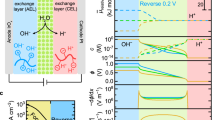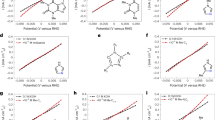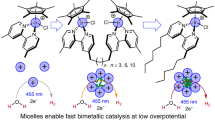Abstract
Tritiated water emissions from nuclear facilities pose significant environmental risks and threaten the sustainability of nuclear energy. However, deep detritiation remains a major challenge due to the nearly indistinguishable physicochemical properties among water isotopologues. Here we present an efficient hydrogen isotope separation process based on catalytic proton exchange. The unique catalysis-promoted proton-transfer pathway found in a metal–organic framework (MIL-101(Cr)) significantly lowers the isotope exchange energy barrier to a previously unachieved level. Incorporating MIL-101(Cr) into a water distillation (WD) system enables a solid–liquid–gas triphasic mass transfer that overcomes the thermodynamic constraints of traditional WD, which relies on a liquid–gas biphasic isotope exchange. The height equivalent to the theoretical plate of the established WD prototype fell by half compared to the existing WD systems, thus increasing the separation efficiency by over four orders of magnitude in a 10-m distillation tower. This work offers an industrially viable and scalable option for cleaning up tritiated water.
This is a preview of subscription content, access via your institution
Access options
Access Nature and 54 other Nature Portfolio journals
Get Nature+, our best-value online-access subscription
27,99 € / 30 days
cancel any time
Subscribe to this journal
Receive 12 digital issues and online access to articles
118,99 € per year
only 9,92 € per issue
Buy this article
- Purchase on SpringerLink
- Instant access to full article PDF
Prices may be subject to local taxes which are calculated during checkout




Similar content being viewed by others
Data availability
The data supporting the findings of this study are available within the article and its Supplementary Information. Further information and answers to questions about the data and modelling approach are available from the corresponding author on request. Source data are provided with this paper.
References
Johnston, W. M. et al. Tritium in nature. Science 113, 1–2 (1951).
Nie, B. et al. Anthropogenic tritium: inventory, discharge, environmental behavior and health effects. Renew. Sustain. Energy Rev. 135, 110188 (2021).
Dobson, R. L. & Cooper, M. F. Tritium toxicity: effect of low-level 3HOH exposure on developing female germ-cells in mouse. Radiat. Res. 58, 91–100 (1974).
Smith, J., Marks, N. & Irwin, T. The risks of radioactive waste water release. Science 382, 31–33 (2023).
Gagnaire, B. et al. Effects of in situ exposure to tritiated natural environments: a multi-biomarker approach using the fathead minnow, Pimephales promelas. Sci. Total Environ. 599–600, 597–611 (2017).
Arcanjo, C. et al. Insights into the modes of action of tritium on the early-life stages of zebrafish, Danio rerio, using transcriptomic and proteomic analyses. J. Environ. Radioact. 261, 107141 (2023).
Di Lombo, M. S. et al. Tritiated thymidine induces developmental delay, oxidative stress and gene overexpression in developing zebrafish (Danio rerio). Aquat. Toxicol. 265, 106766 (2023).
Di Lombo, M. S. et al. Tritiated thymidine internalization in zebrafish early life stages: joint use of experimental procedures and microdosimetry. Radiat. Res. 199, 373–384 (2023).
Wang, D. et al. Implications of Fukushima’s radioactive water discharge on global environmental sustainability. Environ. Sci. Technol. 58, 3061–3064 (2024).
Bondareva, L. et al. Tritium: doses and responses of aquatic living organisms (model experiments). Environments 9, 51 (2022).
Dingwall, S. et al. Human health and the biological effects of tritium in drinking water: prudent policy through science – Addressing the ODWAC new recommendation. Dose-Response 9, 6–31 (2011).
IAEA Management of Waste Containing Tritium and Carbon-14 (IAEA, 2004).
Shere, L. et al. The next generation of low tritium hydrogen isotope separation technologies for future fusion power plants. Int. J. Hydrogen Energy 55, 319–338 (2024).
Liu, M. et al. Barely porous organic cages for hydrogen isotope separation. Science 366, 613–620 (2019).
Miller, A. I. Heavy water: a manufacturers’ guide for the hydrogen century. Can. Nucl. Soc. Bull. 22, 1–14 (2001).
Oh, H. & Hirscher, M. Quantum sieving for separation of hydrogen isotopes using MOFs. Eur. J. Inorg. Chem. 27, 4278–4289 (2016).
Lozada-Hidalgo, M. et al. Scalable and efficient separation of hydrogen isotopes using graphene-based electrochemical pumping. Nat. Commun. 8, 15215 (2017).
Magomedbekov, E. P. et al. Water distillation as a method of detritiation of heavy-water moderator. Theor. Found. Chem. Eng. 51, 384–391 (2017).
Horita, J. et al. in Aqueous Systems at Elevated Temperatures and Pressures (eds Palmer, D. A. et al.) 277–319 (Elsevier, 2004).
Price, A. H. Vapour pressure of tritiated water. Nature 181, 262 (1958).
Ceriotti, M. et al. Nuclear quantum effects in water and aqueous systems: experiment, theory, and current challenges. Chem. Rev. 116, 7529–7550 (2016).
Gao, X. et al. Hydrophilic modification of packings for water distillation and its mass transfer performance. Chem. Eng. Process. Process Intensif. 157, 108130 (2020).
Fu, X. et al. Superhydrophilic metal-organic frameworks film modified surface for tritium removal from tritiated heavy water. Microporous Mesoporous Mater. 348, 112387 (2023).
Li, J. et al. A 3D extra-large-pore zeolite enabled by 1D-to-3D topotactic condensation of a chain silicate. Science 379, 283–287 (2023).
Hanikel, N. et al. Evolution of water structures in metal-organic frameworks for improved atmospheric water harvesting. Science 374, 454–457 (2021).
Agmon, N. The Grotthuss mechanism. Chem. Phys. Lett. 244, 456–462 (1995).
Wu, X. et al. Diffusion-free Grotthuss topochemistry for high-rate and long-life proton batteries. Nat. Energy 4, 123–130 (2019).
Eriksson, U. K. et al. Subangstrom resolution X-ray structure details aquaporin-water interactions. Science 340, 1346–1349 (2013).
Rae, H. K. in Separation of Hydrogen Isotopes (ed. Rae, H. K.) 1–26 (ACS Publications, 1978).
Zorainy, M. Y. et al. Revisiting the MIL-101 metal–organic framework: design, synthesis, modifications, advances, and recent applications. J. Mater. Chem. A 9, 22159–22217 (2021).
Férey, G. et al. A chromium terephthalate-based solid with unusually large pore volumes and surface area. Science 309, 2040–2042 (2005).
Leus, K. et al. Systematic study of the chemical and hydrothermal stability of selected ‘stable’ metal organic frameworks. Microporous Mesoporous Mater. 226, 110–116 (2016).
Liang, J. et al. Macroscopic heterostructure membrane of graphene oxide/porous graphene/graphene oxide for selective separation of deuterium water from natural water. Adv. Mater. 34, e2206524 (2022).
Su, Y. et al. Separating water isotopologues using diffusion-regulatory porous materials. Nature 611, 289–294 (2022).
Zheng, Z. et al. High-yield, green and scalable methods for producing MOF-303 for water harvesting from desert air. Nat. Protoc. 18, 136–156 (2023).
Zhao, T. et al. High-yield, fluoride-free and large-scale synthesis of MIL-101(Cr). Dalton Trans. 44, 16791–16801 (2015).
Cavka, J. H. et al. A new zirconium inorganic building brick forming metal organic frameworks with exceptional stability. J. Am. Chem. Soc. 130, 13850–13851 (2008).
Chui, S. S. et al. A chemically functionalizable nanoporous material [Cu3(TMA)2(H2O)3]n. Science 283, 1148–1150 (1999).
Nordfors, D. et al. Isotopic effects in XPS spectra of H2O and D2O. J. Phys. Colloq. 48, C9-789-C789-792 (1987).
Yang, W. et al. Insights into the interaction between immobilized biocatalysts and metal-organic frameworks: a case study of PCN-333. JACS Au 1, 2172–2181 (2021).
Čendak, T. et al. Indomethacin embedded into MIL-101 frameworks: a solid-state NMR study. J. Phys. Chem. C 118, 6140–6150 (2014).
Taylor, J. M. et al. Facile proton conduction via ordered water molecules in a phosphonate metal-organic framework. J. Am. Chem. Soc. 132, 14055–14057 (2010).
Seifrid, M. et al. Insight into the structures and dynamics of organic semiconductors through solid-state NMR spectroscopy. Nat. Rev. Mater. 5, 910–930 (2020).
Miho, Y. et al. Tritium water distillation assisted with adsorption and isotopic exchange. Fusion Sci. Technol. 71, 326–332 (2017).
Li, S. et al. Tuning the morphology and adsorption capacity of Al-MIL-101 analogues with Fe3+ for phosphorus removal from water. J. Colloid Interface Sci. 560, 321–329 (2020).
Jin, Y. et al. Modular construction of an MIL-101(Fe)@MIL-100(Fe) dual-compartment nanoreactor and its boosted photocatalytic activity toward tetracycline. ACS Appl. Mater. Interfaces 14, 48285–48295 (2022).
Wang, Z. et al. Green synthesis of MIL-100(Fe) derivatives and revealing their structure-activity relationship for 2,4-dichlorophenol photodegradation. Chemosphere 291, 132950 (2022).
Lee, H. et al. Mussel-inspired surface chemistry for multifunctional coatings. Science 318, 426–430 (2007).
Frisch, M. et al. Gaussian 09, Revision A. 02 (Gaussian, 2004).
Becke, A. D. Density-functional thermochemistry. III. The role of exact exchange. J. Chem. Phys. 98, 5648–5652 (1993).
Grimme, S. et al. Effect of the damping function in dispersion corrected density functional theory. J. Comput. Chem. 32, 1456–1465 (2011).
Rassolov, V. A. et al. 6-31G* basis set for atoms K through Zn. J. Chem. Phys. 109, 1223–1229 (1998).
Frisch, M. J. et al. Self-consistent molecular-orbital methods. 25. Supplementary functions for Gaussian-basis sets. J. Chem. Phys. 80, 3265–3269 (1984).
Clark, T. et al. Efficient diffuse function-augmented basis sets for anion calculations. III. The 3-21+G basis set for first-row elements, Li–F. J. Comput. Chem. 4, 294–301 (1983).
Raghavachari, K. et al. Highly correlated systems: excitation-energies of 1st row transition-metals Sc-Cu. J. Chem. Phys. 91, 1062–1065 (1989).
Tomasi, J. et al. Molecular interactions in solution: an overview of methods based on continuous distributions of the solvent. Chem. Rev. 94, 2027–2094 (1994).
Delley, B. et al. An all-electron numerical-method for solving the local density functional for polyatomic molecules. J. Chem. Phys. 92, 508–517 (1990).
Delley, B. et al. From molecules to solids with the DMol3 approach. J. Chem. Phys. 113, 7756–7764 (2000).
Fei, S. et al. Analysis of the water adsorption mechanism in metal–organic framework MIL-101(Cr) by molecular simulations. J. Phys. Chem. C 125, 26755–26769 (2021).
Acknowledgements
We would like to acknowledge the support from the following funding sources: the National Natural Science Foundation of China (Grant Nos. 22425061 to S.W., 22276132 to H.L., 22206144 to L.C., 22406135 to T.W., 22125602 and 22076078 to L.M. and 22306139 to A.J.), the National Natural Key R&D Program of China (Grant No. 2022YFE0105300 to S.W.), the New Cornerstone Science Foundation through the Xplorer Prize, a project funded by the Priority Academic Program Development of Jiangsu Higher Education Institutions and the Postdoctoral Fellowship Program of CPSF (GZC 20231888 to T.W.). We also thank C. Zhang from Anhui University of Science and Technology for his help with the theoretical calculations.
Author information
Authors and Affiliations
Contributions
S.W. conceived and supervised the project. H.L., Q.Y. and S.Z. completed the experiments and collected and analysed the data. N.L. and X.D. contributed to the theoretical calculations. L.C. was involved in data analysis and writing of the paper. J.S. analysed the ssNMR data. T.W., N.S., J.X., J.L., L.H., A.J., Z.X., G.Z., C.G., H.Y., J.C., L.M., S.G., K.L., P.L., X.L., X.O., Y.P., X.Z. and Z.C. participated in project discussions and provided valuable insights. All authors contributed to refining the paper before submission.
Corresponding author
Ethics declarations
Competing interests
S.W., H.L., Q.Y., S.Z., A.J., T.W. and J.L. and Soochow University have filed a patent based on the results presented. The other authors declare no competing interests.
Peer review
Peer review information
Nature Sustainability thanks Zhan Li, Ken-ichi Otake and Sheng Zhang for their contribution to the peer review of this work.
Additional information
Publisher’s note Springer Nature remains neutral with regard to jurisdictional claims in published maps and institutional affiliations.
Supplementary information
Supplementary Information
The PDF file includes supplementary materials, namely text, Supplementary Figs. 1–46, Tables 1–3 and References 1–34.
Supplementary Video 1
H/D exchange path for MIL-101(Al). As MIL-101(Al) and MIL-101(Cr) are isomorphic systems, the spin complexity of the Cr atoms needs to be considered. Thus, MIL-101(Al) was chosen as the simulation object to speed up the calculations. The kinetic simulation of proton transfer in the water bridge of MIL-101(Al) shows that a stable structure of three H2O molecules can be formed between Al–OH2 and Al–OH−. Protons are repeatedly transferred back and forth in the hydrogen bonding lattice of this water bridge to realize the H/D exchange process, which is very rapid. The ultrafast exchange rate was at the femtosecond level. The kinetic results show that the proton exchange process was fast and frequent at 350 K. Colour code: Al, purple; O, red; C, grey; H, white.
Source data
Source Data Fig. 3
Water vapour adsorption data, ssNMR processing data, etc.
Source Data Fig. 4
Tritium WD data.
Rights and permissions
Springer Nature or its licensor (e.g. a society or other partner) holds exclusive rights to this article under a publishing agreement with the author(s) or other rightsholder(s); author self-archiving of the accepted manuscript version of this article is solely governed by the terms of such publishing agreement and applicable law.
About this article
Cite this article
Liu, H., Yang, Q., Luan, N. et al. Catalytic proton exchange in water distillation for efficient tritiated water clean-up. Nat Sustain 8, 553–561 (2025). https://doi.org/10.1038/s41893-025-01537-5
Received:
Accepted:
Published:
Issue Date:
DOI: https://doi.org/10.1038/s41893-025-01537-5



